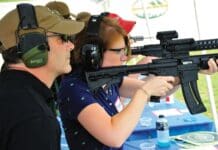[HTML1]
I get that you can’t be 100 percent tactically accurate when you’re a moviemaker going for yucks (or action adventure). But I’m still thinking that this operator should have checked left and right when he brought the new $1142 SIG SAUER MK25 back to his body after firing. The goon check should be so drilled into his subconscious mind that it’s inescapably instinctive. ‘Cause if you don’t practice checking your environment after shooting or brandishing your gun, you stand a pretty good chance of getting shot by someone other than the person you just shot, or shot at . . .
What are the exact odds that you’ll face multiple attackers in an armed self-defense scenario? Who cares? If you train yourself to deal with the possibility of more than one bad guy you lose nothing if he or she’s all by their lonesome. If you train yourself to counter just one bad guy, you run the risk of losing your life, or the life of a loved one. As the Brits say, it’s the bus you don’t see that kills you.
That said, scanning your environs immediately after a Defensive Gun Use (DGU) is about more than identifying—then engaging or avoiding—a secondary or tertiary (or greater) threat. It’s about maintaining ANY situational awareness.
Truth be told (thanks Christian), shooting someone is a fascinating business. Nothing quite captures your attention like watching the effects of your bullet(s) on the bad guy’s body. The tendency is to stare, transfixed, at the bloody aftermath of your ballistic defense.
Perhaps it’s an evolutionary tunnel vision thing; you want to make sure the Bad Guy’s out of action. Maybe it’s a love that dare not speak it’s name (a natural attraction to extreme violence and gore). Whatever. Train yourself out of it.
Through endless relentless repetition at the range, train yourself to bring your gun in and check left and right—really check left and right—after every. Single. String. That way you’ll do it post-DGU. Or at least you might.
If your training holds, you’ll break eye contact with the hopefully scarpering or prone perp and find out what else is happening around you: new threats (including cops), the health and safety of your friends and/or family, the location of concealment and cover, potential escape routes, etc.
Your decisions in a DGU are only as good as the information they’re based on. If you limit your information to the amount of bad guy bodily fluid seepage, you’ll make bad decisions in a life-or-death situation. Great shooting. Too bad he got killed.
You know the old expression it ain’t over until the fat lady sings? Not true. It’s not over until you leave the theater. And maybe not even then.




Oh so true, I was taught to begin scanning right around the time I pulled the trigger the third time (a modified Rhodesian Drill).
Meh, the “goon check” is not necceary for Every. Single. Draw. Just as periods are not neccesary to create emphasis and drama every. time. you. want. to. draw. the. readers. attention. You could use commas, semicolons, italics or bold to enhance the copy and draw the readers attention. It is all about using the Proper Tactics for the Right Situation. I get situational awareness and the desire to emmulate the big boys and train like a Navy Seal for the event you may be involved in a DGU, however it is possible to over train for a situation. If you pull your weapon and shoot your target keep, contact eye with the body until you are sure the the target is completely incapeable of doing you harm and then scan if it’s necceary. In most civilian DGU’s there are no secondary targets, so make sure the one you shoot is down before you take your eyes off of the target. Then unload your firearm and wait to be arrested. Unless you are Spec Ops train for real life.
“In most civilian DGU’s there are no secondary targets, so make sure the one you shoot is down before you take your eyes off of the target. ”
Bad guys rarely travel in packs of one.If you are lucky,the others will run off when their buddy hits the ground but it is better to be aware of your surrounding and see nothing than to have the bad guys buddies avenge him!
“Bad guys rarely travel in packs of one.”
Where did you read that?
“unload your firearm”??? So much for Rule #1.
Not only should you conduct a Tactical Reload, given cover and a “safe” situation, but you should reholster reluctantly.
If the cops arrive before you’ve reholstered, drop the weapon (not place it on the ground, but drop like a hot potato), put hands way up, and say “Thank God you’re here, I’m the one who called.”
Unless you are Jack Slater and live in the fictional world of the Last Action Hero firearms can achieve a state of being “unloaded” wherein the firearm does not contain ammunition. Rule one doesn’t mean the firearms cannot ever attain the status of unloaded, rather that you should treat as if they are always loaded.
Given the rather jumpy nature of Police Officers, I would rather be proactive and prepare the gun and myself to be handed over to the police custody ahead of time rather than have them show up and give them a reason to shoot me.
Most trainig sites that have some sort of Fighting Pistol course teach Rule #1 as “Every weapon is always loaded.” Just because an initial threat is gone, does not mean the fight is over or that another fight cannot begin. We carry a firearm for self-defense and that firearm is not much good without ammo.
Fight, assess, scan, top-off…. move off the x and call the police.
Unloaded firearms belong in a gun safe.
Click here for the the FBI’s chart Murder by Victim/Offender Situations, 2010. [h/t to the NSSF for helping me track these numbers down]
Although I’d bet to dollars to donuts that the majority of the 12,996 murders were gang or drug-related, 1,641 or 12.6 percent of them fell under “single victim/multiple offenders.”
The smart money says that the percentage of assaults involving single vic, multiple perps is just as high. I’m thinking higher.
“really check left and right”
… and behind. 360 degree scans are a must, assuming the initial threat is no longer a threat.
The problem with rote scanning after shooting a bad guy is that the eye will very likely miss seeing a threat.
The way to avoid the rote scan problem is situational awareness. Most gun incidents don’t just brew up out of nowhere. If I’m caught off guard in a life threatening situation, it’s because I wasn’t paying attention. I should already have the situation well scoped out before I pull out the pistol.
The shoot then scan smacks of dusty streets, chawin’ tabaccy and Colt 45’s.
“Perhaps it’s an evolutionary tunnel vision thing; you want to make sure the Bad Guy’s out of action. Maybe it’s a love that dare not speak it’s name (a natural attraction to extreme violence and gore). Whatever. Train yourself out of it.”
It’s like flinching when something fast moves towards your head (especially your eyes). Natural reflex is to stop that something getting into your eye or brace yourself for the impending blow, but if you practice some sort of combatives you soon learn that the simple caveman reflex isn’t of much use anymore and it is more important to see what else is moving in your direction in order to react appropriately, and thus train yourself out of it.
This point was beautifully illustrated when I saw a good Samaritan stop a purse snatching only to be laid out cold on the sidewalk by the pipe-swinging backup man for the purse snatcher.
I really hate the modern trend of civilian “gun guys” to use overly-stylized body movements and gestures, such as pulling the pistol straight back to their face and then giving the perfunctory look in both directions. That stuff is a bunch of self-defense TV show faggotry. If you are doing it to look kool, then stop, because it looks seriously gay. If you are seriously worried about a follow up attack, then you might want to simulate moving: finding better cover, un-assing the AO, etc. Just standing there like a big target is not a good survival skill. End of rant.
As you rightly point out, perfunctory goon checks are worse than useless. They induce a sense of false confidence and look . . . tactistupid.
A lot of people train with a partner who stands behind them. After they shoot, they have to look and see how many fingers their training partner’s holding up. Or what object they’re carrying. Or both.
Oh! If we could only have ranges where we could move! The most important aspect of armed self-defense, or any defense, really. Sadly, most ranges aren’t set up for shoot and move. Or move and shoot. Or move and don’t shoot.
Some of us have those kinds of ranges.
The video was really amusing, btw. Love how he goes back into the water.
Also, good tip for the “scan” involving a partner!
Sadly, most ranges aren’t set up for shoot and move. Or move and shoot. Or move and don’t shoot.
Or run like Usain Bolt and shoot, which is what I intend to do if and when. It’s gonna be “feets and Smith & Wesson, don’t fail me now.”
The real crime is the editor not cutting before the actor smirks. Amateurish. I gotta talk with my SIG marketing friends about that.
Why the hell would you throw away your primary?
Because they do it in the movies?
Because,can you say “tongue-in-cheek comedic effect”. I hope you understand that throw away wasn’t serious. I think the point was to focus on the ruggedness of the Mark 25 in a cheeky manner. I personally thought it was a hilarious way to get a point across;you know,kind of spoofy.
I get reminded of the necessity of this every time some knucklehead at the range wanders down to his target while the rest of us are shooting. (“Benefits” of no range officer. . .) It’s a study in how to keep aware of what’s going on around me.
Comments are closed.